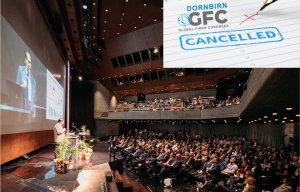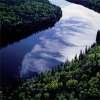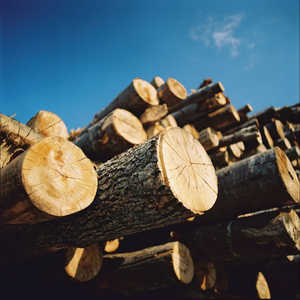
Dornbirn-GFC 2020 cancelled
The tremendous potential of TencelWeb – a new technology which allows the direct manufacture of cellulosic nonwoven webs from Lyocell spinning solution – was outlined at the recent 49th Manmade Fibre Conference held in Dornbirn, Austria. Given, Lenzing’s just-announced commitment to greatly expanding the capacity of its Tencel fibre operations, this is a technology which is poised to be widely adopted once perfected, given the drive towards alternatives to petro

8th October 2010
Innovation in Textiles
|
Dornbirn
 The tremendous potential of TencelWeb – a new technology which allows the direct manufacture of cellulosic nonwoven webs from Lyocell spinning solution – was outlined at the recent 49th Manmade Fibre Conference held in Dornbirn, Austria.
The tremendous potential of TencelWeb – a new technology which allows the direct manufacture of cellulosic nonwoven webs from Lyocell spinning solution – was outlined at the recent 49th Manmade Fibre Conference held in Dornbirn, Austria.
Given, Lenzing’s just-announced commitment to greatly expanding the capacity of its Tencel fibre operations, this is a technology which is poised to be widely adopted once perfected, given the drive towards alternatives to petrochemical-based raw materials for the manufacture of nonwoven fabrics.
In the past, meltblown nonwovens technology for cellulose proved uneconomic due to the low fibre content of Lyocell spinning solution and the resulting low output from spinning beams, explained Miro Einzmann of Lenzing at the Dornbirn conference.
Newer approaches which were developed for synthetic web manufacture suggested higher productivities and gave rise to a reassessment of the potential for a productive and cost-effective web formation technology based on Lyocell spinning solution. A successful development of this technology would allow the manufacture of cellulosic fine fibre products and lightweight webs.
As officially announced in July 2008 Lenzing, as the world market leader in cellulose staple fibres and , signed a joint development agreement to investigate potential meltblown nonwoven technologies for cellulose.
Weyerhaeuser is contributing extensive knowledge on pulp manufacture and paper production technology while Lenzing is adding its Lyocell expertise.
Both companies have extensive IP rights in this field.
Up until the end of 2008, lab scale trials with small jet units were carried-out, but in parallel, the design and development programme for a pilot plant was driven forward.
When results looked promising enough the decision was made to build a larger pilot line in order to better understand the key process economics and the capabilities of the TencelWeb process.
Now, the pilot line is located at Lenzing, Austria and started operation in May 2009.
The line is designed for production of up to 150 kg/h of cellulose web, with the possibility to run more than one spinning beam.
Due to the importance of filament coagulation a highly flexible arrangement of coagulation spray bars between the meltblown head and the collection belt was installed.
In order to investigate the washing efficiency, as well as the mass balance recover of NMMO – N-methylmorpholine oxide which is used with water to form cellulose solutions from which cellulose films and fibres are obtained – the web passes several wash stations before it is collected in wet state on a winder arm. The pilot line can be operated at collection speeds of up to 300 m/min. After-treatment and web drying is currently carried out separately.
“As mentioned, the pilot line was commissioned in May 2009,” Mr Einzmann told attendees at Dornbirn. “In the following months we mainly focused on spinning development and web uniformity improvement with half-width jet units. In November 2009 we achieved sustained stable spinning at good throughput combined with good web quality. After another intensive phase of jet development we carried-out the first full-sized jet trial in April 2010. A month later we increased the jet productivity limit for the half-width jet unit above 30 kg/h cellulose web.
“After more than a year of pilot plant operation, a better understanding of the key properties and correlations between process conditions and web properties has been achieved. Typically, average filament diameters in the range of 2-20 μm can be produced. The average filament diameter increases with the dope rate and decreases with the air flow and temperature. In analogy to other meltblown processes on a synthetic basis, the filament diameter variation is large compared to staple fibres.”
The tensile properties of the nonwoven products are controlled by the average filament diameters, web formation procedure and the web basis weights, he explained.
As with other textile products, tenacity increases with basis weight and increases with filament stretching.
“In general, tenacity in MD direction is larger than in CD direction,” Mr Einzmann said. “Product basis weight in the TencelWeb process is mainly controlled by the dope rate and the belt speed.”
Typical webs are produced with basis weights between five and 100 gsm, although there is no technical reason against the manufacture of heavier products.
The sorption properties of the TencelWeb products, however, are only partly comparable to other Lyocell nonwovens and textiles. The water absorption capacity decreases as expected with the basis weight as nonwoven density increases.
For a typical 30-50 gsm dried product, the absorption capacity varies between 800 and 1200 % while undried material shows significantly higher absorption capacities around 2,000%. On the other hand, water retention seems to be relatively independent of the process conditions as general values above 100% are observed.
“On the basis of our earlier lab trials we expected the TencelWeb products to show a generally low-lint behaviour, but in fact we found that linting strongly depends on coagulation and other process conditions,” said Mr Einzmann. “Against this background of properties, our main market focus will be applications which are based on fine fibre webs, lightweight fabrics and low lint materials. Until the end of this year, we will continue to develop the product performance, improve the productivity of our TencelWeb process and refine estimates of the process economics in advance of decisions in respect of commercialising the technology.

Business intelligence for the fibre, textiles and apparel industries: technologies, innovations, markets, investments, trade policy, sourcing, strategy...
Find out more